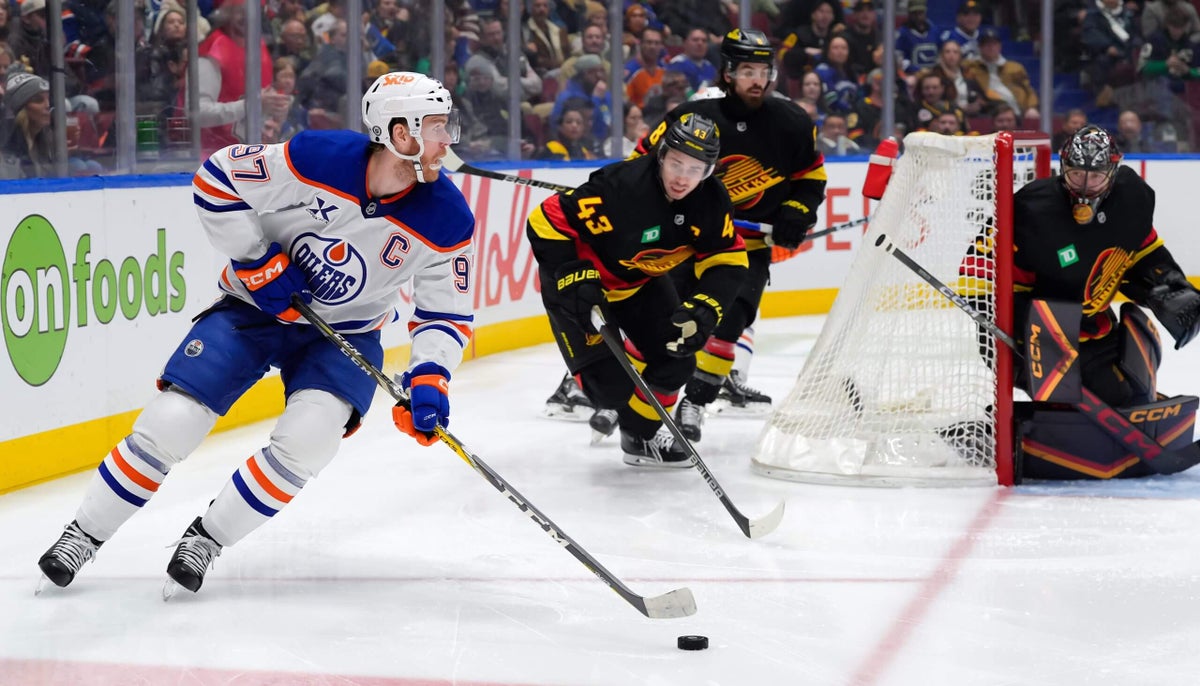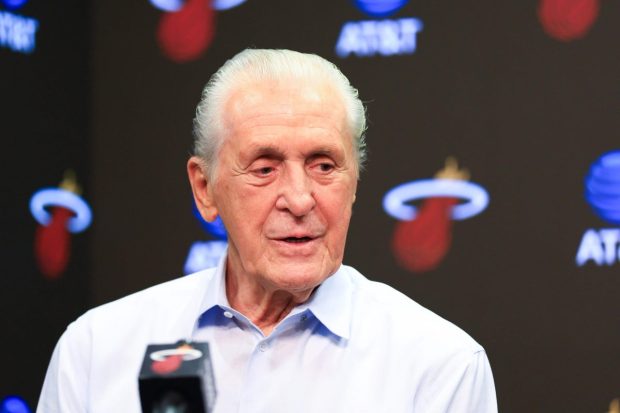

The entertainment value of the Stanley Cup playoffs so far has been through the roof.
Despite the Vancouver Canucks’ absence this spring, if you’re regularly tuning into NHL playoff games then you know that, without question, this is the best the NHL product has been in decades.
The chaos, speed and physicality of these games have been exceptional. The momentum swings have been uncharacteristically dramatic, and constant. The skill level has never been higher across the league. And while the officiating has been uneven in moments, and always will be given the pace of these games, the true game-deciding calls or missed calls have been relatively rare (despite the missed trip on Viktor Arvidsson in overtime on Thursday night).
Advertisement
As I’ve tuned into these games and considered the state of the league and how the game is evolving in real time right before our eyes, my thoughts have kept circling back to the Canucks.
This is an organization that sits on the precipice of a critical offseason. A team that faces a series of difficult decisions this summer, with significant holes in its lineup and a ton of pressure to get back on track after a deeply disappointing 2024-25 campaign.
I wanted to take some time to spell it all out. Here are four takeaways that I’ve been turning over in my head from the playoffs so far, and how they’ve impacted my thinking about the Canucks’ offseason priorities.
1. It’s a star-driven league, in a way it hasn’t been in a generation
The Mikko Rantanen experience in these playoffs, like the Matthew Tkachuk experience that preceded it or the legendary Connor McDavid run through the playoffs last season, stands out as the latest testament to the value of elite talent at the most important time of year.
Having the horses when the chips are down in playoff hockey has always mattered, of course. This isn’t new, necessarily. What’s important to note, however, is that the NHL is evolving rapidly at the moment in a way that seems to have sharpened the edge that the most skilled, talented players in the league can provide their teams.
The key here, really, is the drop in average save percentage. You’ll see precious few 2-1 or 3-2 results in the playoffs now. The truly throwback, low-event playoff series we’ve witnessed this spring — like the Toronto Maple Leafs versus Ottawa Senators first-round series, and what we’ve been served up by the Washington Capitals and the Carolina Hurricanes through two games — are the exception, not the norm.
As percentages have become unfixed relative to what we used to see a decade ago, we’re seeing far fewer examples of games in which one team gets “goalie’d,” or where the result feels almost wholly random, or where the edge that one opponent has over their opponent as a result of a superior third forward line is insurmountable.
Advertisement
Instead, based on what we’ve seen in the playoffs the past couple of seasons, that era of the NHL — in which territorial control was everything, and depth and goaltending felt like everything in the postseason — is being replaced. We’re now watching a game in which the absolute best players on the ice, the players who are more likely to manufacture offence and score goals and break games open, are more likely to have the decisive impact on whether their team wins or loses.
You can find any number of examples of this across the postseason, from the brilliance of William Nylander to the continued absurdity of McDavid and Leon Draisaitl to the duress that Matt Boldy and Kiril Kaprizov inflicted on Vegas in Round 1. The Rantanen example, however, is the most compelling example of the changing importance of winning at the top end of the lineup.
In part, the lessons of Rantanen’s dominance seem so vivid because he single-handedly dispatched his former team. The Colorado Avalanche, unable to come to terms with Rantanen on an extension, opted to trade him ahead of the NHL trade deadline. The deal launched an impressive mid-stream retooling effort by the Avalanche, as the club successfully shored up their depth, their blue line and their goaltending with a series of savvy deals during the season.
After Rantanen didn’t really work out in Carolina, for on-ice reasons, off-ice reasons and hockey business reasons too, the Hurricanes sent him to the Dallas Stars for an absolute haul in early March.
At the time of the Rantanen acquisition, the Stars were already down their top defender — Miro Heiskanen — who had an uncertain timeline to return. Dallas, however, a longstanding striver class team that often overachieved on run deep into the postseason, but kept running into Nikita Kucherov, or McDavid-type roadblocks in previous years, decided to push their chips into the centre of the table on a ceiling raising superstar – rather than prioritize a seemingly more pressing hockey fit gap in their lineup, on the right side of their blue line.
Advertisement
For a minute, toward the tail end of the regular season and in a Game 1 demolition at the hands of the Avalanche in round one, it looked like Dallas’ gamble to prioritize their long-term ceiling at the expense of their short-term needs would cost them. The Stars, however, steadied themselves against the Avalanche, and then Rantanen eliminated a two-goal deficit in the third period of Game 7 with one of the most ridiculous individual playoff performances we’ve seen in years.
The Avalanche’s decision to prioritize depth, hockey fit and a higher floor proved costly; while the Stars — like the Panthers before them — were rewarded for prioritizing superstar upside felt telling. Like a bright shining indicator light foreshadowing what the NHL game is moving toward.
The implications of hockey evolving to be a more star-driven game are significant, and multi-faceted for the Canucks this summer.
Of course, that discussion has to start with Quinn Hughes. While Hughes wasn’t at his dominant best during the club’s 2024 playoff run, the fact remains that he’s the sort of game-breaking, math-shifting talent capable of elevating his team and determining outcomes at this time of year.
We don’t have to go over the uncertainty that surrounds him beyond next season contractually yet again in this space, but we’d be remiss if we didn’t note that Hughes’ quality and dominance is a major reason to believe that this Canucks side can bounce back next season — and, perhaps, even be a tough out come playoff time in 12 months.
The other side of this coin is the big Elias Pettersson question, and how the Canucks should proceed with their struggling, mercurial top-line centre. As significant as Pettersson’s deterioration has been, as noisy as it’s been around him over the past 14 months or so, there can be no question that he’s flirted with being a superstar-level producer and performer for long stretches of his NHL career to this point.
As risky as it seems to hold onto Pettersson at the moment given the size of his contract and the scale of his struggles, in a NHL where elite talent is trending toward shaping outcomes to a greater degree than we’ve seen since the widespread adoption of the butterfly, trading players with Pettersson-level upside seems pretty foolish.
Advertisement
2. Are we sure that “defence wins championships” still?
As a corollary to the star-driven evolution of the NHL game, which has been on such a stunning, vibrant display in the postseason so far, we may also need to begin to skeptically question the old hockey bromide that “defence wins championships.” At the very least, it’s a maxim that seems to be in need of an update.
Obviously defence matters enormously in hockey, and it always will. Part of the implications of the “defence wins championships” maxim, however, is that it suggests that defensive solidity is the primary driver of on-ice results. That it takes precedence over offensive generation as a defining characteristic of a championship team. And, I’m not especially sure that holds water anymore.
What’s really key to grapple with here is that as save percentage has dropped, we’ve also seen teams probe and attack with different types of emphasis than they used to. Teams are generating far fewer shots on goal in these playoffs than they typically have in previous seasons, continuing a trend that really shaped this NHL season.
Consider that before the pandemic, during the 2018-19 season, 22 of the NHL’s 31 teams averaged over 30 shots on goal per game. Last season, the 2023-24 campaign, that number was reduced to 19 of 32.
This year, however, we’ve seen a sharp drop-off in shot volume as players and teams have really prioritized thoughtful attacking tactics — including shooting through layered traffic, and attacking goaltenders during transitions — and the drop-off in shot volume has been massive. This season, only four of the NHL’s 32 teams averaged over 30 shots per game.
Notably, all four of those teams (Edmonton, Carolina, Florida and Vegas) are still alive in the playoffs.
As the game evolves and shots on goal become ever more difficult to come by, the ability to manufacture quality looks and scoring chances takes on a greater degree of importance. If we’ve learned anything from these playoffs so far, it’s that the ability to pull a result out of the fire is essential for a team hoping to go on a long run and win 16 playoff games.
Advertisement
And the teams that can actually generate when the pace and stress is at it’s highest, against the absolute best competition the NHL has to offer, are the teams to be feared at this time of year.
You still need to be great defensively to win the Stanley Cup, of course, and that will never ever change. In the contemporary NHL, however, defensive excellence is insufficient on its own. It’s offence that wins playoff games.
From a Canucks perspective, then, this club is going to need significant work. Vancouver prevents shots at a very strong clip, and has over the past few seasons. The Canucks, however, struggle mightily to generate shots — something that was notable even during their successful 2024 run in the playoffs — and will need to graft serious offensive juice into their lineup this summer if they hope to be a tough out come playoff time.
3. The “workhorse” starting goaltender is on extinction watch
Twelve NHL goaltenders started 55 games or more this season, and only two of those 12 — Connor Hellebuyck and Jake Oettinger — are still playing playoff hockey in the second round. They’re also playing against one another, meaning that only one team that utilized a true “workhorse” starting goaltender this season will compete for the conference final.
The true, workhorse No. 1 netminder has been going rapidly extinct in the NHL across the past half decade, and that trend has continued this spring. As we watch fresher goaltenders, like Anthony Stolarz and Calvin Pickard, outplay their more heavily utilized counterparts in the playoffs (most notably Hellebuyck), this trend could — and probably should — become even more pronounced next season.
From a Vancouver perspective, this could be an argument for extending Thatcher Demko, especially if the risk is shared on Demko’s next contract and the number is fair. Having multiple quality goaltenders and sharing the workload during the regular season is a straightforward way of giving your team an edge come playoff time.
4. In a world where no lead is safe, end-game excellence is key
The Winnipeg Jets’ Game 7 comeback against the St. Louis Blues felt like magic. Improbable drama. An unforgettable, could-not-be-scripted spectacle of playoff hockey.
Advertisement
The truth, however, is that no team in the NHL scored goals at a higher rate while trailing with their net empty than the Jets did this past season. And no team in the NHL surrendered goals against at a higher rate when holding a lead against teams that had pulled their goalie than the Blues.
Right now, every single game feels like it’s turning on a knife’s edge. The swings in momentum are incredible, and the number of comebacks we’ve witnessed has been stunning.
All of which is great news for the viewer. A 3-1 playoff game with 10 minutes remaining in regulation is no longer a game that’s been decided. There’s drama and stakes right down to the final second of playoff games right now, more often than not.
For teams, however, and NHL players, the increased difficulty of holding a lead and killing an opponent should result in a greater emphasis on the importance of end-game strategy. And from a Canucks perspective, in truth, this is where the loss of head coach Rick Tocchet may be most sorely felt.
Under Tocchet, the Canucks were generally fantastic in end-game situations. The club finished in the top 10 in both of the last two seasons in terms of generating goals when trailing and their goaltender pulled (fifth in 2023-24, ninth in 2024-25). The club was also excellent at defending leads with opponent’s net empty during the 2023-24 season, before becoming porous in end-game situations this latest season.
Tocchet’s feel for and execution of end-game tactics was a critical strength of this team, and based on what we’ve seen in the playoffs, should be an area of emphasis for Vancouver’s next head coach.
(Photo: Derek Cain / Getty Images)
This news was originally published on this post .










Be the first to leave a comment